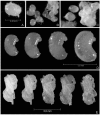Oviposition, Life Cycle, and Longevity of the Leaf-Cutting Ant Acromyrmex rugosus rugosus
- PMID: 28777297
- PMCID: PMC5620700
- DOI: 10.3390/insects8030080
Oviposition, Life Cycle, and Longevity of the Leaf-Cutting Ant Acromyrmex rugosus rugosus
Abstract
Studies related to the demography of individual members from ant colonies have received little attention, although they are the basis to understanding the population dynamics of colonies. Thus, the objective of this work was to study the queen oviposition rate and the duration of the life cycle and longevity of Acromyrmex rugosus rugosus workers. To determine the oviposition rate, queens from three colonies were individually placed in plastic containers, and the eggs laid were quantified over a 96 h period. The development of the immature forms was observed every 24 h, with which the duration of each stage of development was determined. To verify the longevity of workers, the newly emerged adults were marked and daily observations were made. According to the results, there is variation in the development time of immature forms within the colony itself and between colonies. In addition, the number of eggs deposited was also inconstant in the three colonies, ranging from 5 to 119 eggs per day, while the longevity of workers varied from 3 to 7 months. Occasionally, it was found that the workers feed on the eggs produced by the queen; besides, there was a disappearance of larvae and pupae during the research, indicating a possibility of the practice of cannibalism in this species.
Keywords: cannibalism; leaf-cutting ants; life cycle; oviposition; worker longevity.
Conflict of interest statement
The authors declare no conflict of interest.
Figures





References
-
- Hölldobler B., Wilson E.O. The Ants. Harvard University Press; Cambridge, MA, USA: 1990. p. 732.
-
- Marinho C.G.S., Della Lucia T.M.C. Egg-laying in Acromyrmex spp. (Hymenoptera: Formicidae) under laboratory conditions. Biociências. 1998;6:71–79.
-
- Passera L. Overview. In: Vander Meer R.K., Jaffé K., Cedano A., editors. Applied Myrmecology: A World Perspective. Westview Press; Boulder, CO, USA: 1990. pp. 133–137.
-
- Wilson E.O. The Insect Societies. Belknap Press of Harvard University Press; Cambridge, MA, USA: 1971. p. 548.
-
- Autuori M. Algumas observações sobre formigas cultivadoras de fungo (Hym. Formicidae) Rev. Entomol. 1940;11:215–226.
LinkOut - more resources
Full Text Sources
Other Literature Sources

